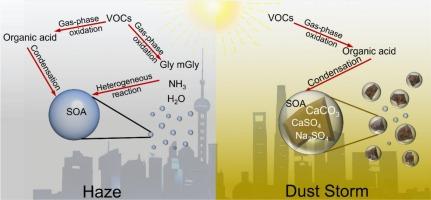上海春季大气气溶胶的化学特征:亚洲粉尘表面二次有机气溶胶的形成机制
IF 4.4
2区 地球科学
Q1 METEOROLOGY & ATMOSPHERIC SCIENCES
引用次数: 0
摘要
无机气溶胶在东亚扬尘远距离传输过程中的化学演化和二次反应进行了广泛的研究。然而,关于粉尘对二次有机气溶胶(SOA)形成的影响的知识仍然不清楚。本研究结合上海地区亚微米气溶胶的在线化学观测和粒径分离气溶胶的离线测量结果,发现在运动期间,SOA以有机气溶胶(OA)为主,包括生物成因SOA (BSOA)、氧合OA (OOA)和水相SOA (aqSOA)。非沙尘暴(NDS)期以aqSOA为主,其次为OOA和BSOA;沙尘暴(DS)期以OOA为主,其次为BSOA, aqSOA较小。BSOA在NDS和DS时期均呈现出相似的尺寸分布模式,在细模态(<2.1 μm)中有一个主峰,在粗模态(>2.1 μm)中有一个小峰。而OOA在NDS期表现出明显的细模态大峰、粗模态小峰、DS期只有一个粗模态大峰的尺寸分布格局。hrams分析结果进一步表明,在活动过程中,OOA主要由羧酸类化合物组成,主要由光化学氧化产生,BSOA主要由异戊二烯的光化学氧化形成,aqSOA主要通过羰基的水相反应产生。与NDS期相比,DS期碱性粉尘颗粒的反应性吸收增强了OOA的形成,特别是在粗态。相反,DS期干燥条件和气溶胶酸度降低抑制了aqSOA和BSOA的形成。本文章由计算机程序翻译,如有差异,请以英文原文为准。

Chemical characterization of atmospheric aerosols in spring Shanghai: Formation mechanism of secondary organic aerosols on Asian dust surface
The chemical evolution and secondary reaction of inorganic aerosol during East Asian dust long-range transport have been extensively investigated. However, knowledge about the impact of dust on secondary organic aerosols (SOA) formation remains unclear. By combining online chemical observation of submicron aerosols and offline measurements of size-segregated aerosols in Shanghai, this study revealed that SOA dominated organic aerosols (OA) during the campaign and comprised biogenic SOA (BSOA), oxygenated OA (OOA) and aqueous-phase SOA (aqSOA). During the non-dust storm (NDS) periods, aqSOA prevailed, followed by OOA and BSOA, while in the dust storm (DS) periods OOA was dominant, followed by BSOA with a minor aqSOA. BSOA presented a similar size distribution pattern in both NDS and DS periods, with a predominant peak in the fine mode (<2.1 μm) and a minor peak in the coarse mode (>2.1 μm). However, OOA displayed a distinct size distribution pattern with a large peak in the fine mode and a small peak in the coarse mode during the NDS periods and only a large coarse-mode peak during the DS periods, respectively. HR-AMS analysis results further suggested that during the campaign OOA are composed of carboxylic acid-like compounds, which were produced largely by photochemical oxidation, BSOA was formed by photochemical oxidation of isoprene, while aqSOA was produced mainly through aqueous-phase reactions of carbonyls. Compared to those in the NDS periods, during the DS periods OOA formation was enhanced through reactive uptake by alkaline dust particles, particularly in the coarse mode. In contrast, aqSOA and BSOA formation was suppressed mainly due to dry conditions and reduced aerosol acidity in the DS periods.
求助全文
通过发布文献求助,成功后即可免费获取论文全文。
去求助
来源期刊

Atmospheric Research
地学-气象与大气科学
CiteScore
9.40
自引率
10.90%
发文量
460
审稿时长
47 days
期刊介绍:
The journal publishes scientific papers (research papers, review articles, letters and notes) dealing with the part of the atmosphere where meteorological events occur. Attention is given to all processes extending from the earth surface to the tropopause, but special emphasis continues to be devoted to the physics of clouds, mesoscale meteorology and air pollution, i.e. atmospheric aerosols; microphysical processes; cloud dynamics and thermodynamics; numerical simulation, climatology, climate change and weather modification.
 求助内容:
求助内容: 应助结果提醒方式:
应助结果提醒方式:


